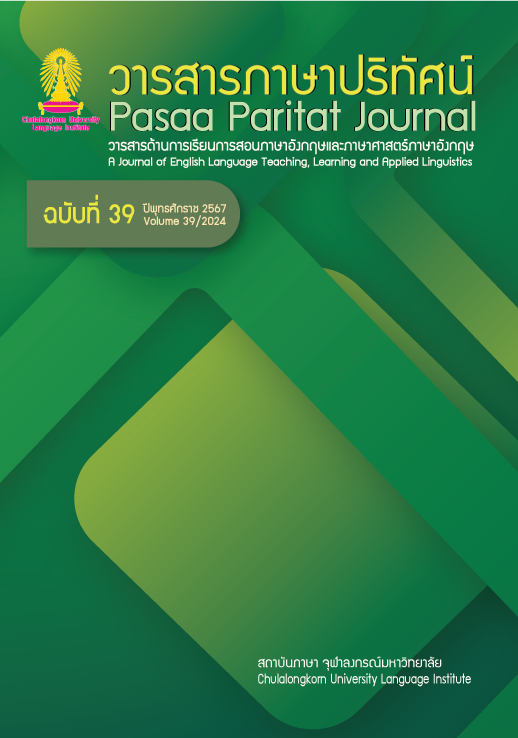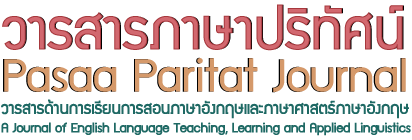ปัญหาการแปลคำที่มีความหมายหลายนัยของนิสิตสาขาภาษาอังกฤษ
DOI:
https://doi.org/10.58837/CHULA.PPJ.39.2คำสำคัญ:
การแปล, ความผิดพลาดในการแปล, การแปลคำที่มีความหมายหลายนัย, ประเภทความผิดพลาดในการแปล, การสอนแปล, กลวิธีการแปลบทคัดย่อ
งานวิจัยนี้มีจุดประสงค์เพื่อนำเสนอประเภทข้อผิดพลาดในการแปลคำที่มีความหมายหลายนัยของนิสิตระดับอุดมศึกษา สาขาภาษาอังกฤษชั้นปีที่ 2 โดยใช้การแบ่งประเภทข้อผิดพลาดตามสมาคมนักแปลแห่งสหรัฐอเมริกา (American Translators Association) โดยจะเน้นการวิเคราะห์ความผิดพลาดเกี่ยวกับการแปลผิดความหมาย (Meaning Transfer) ในด้านความถี่ ผลการวิจัยพบว่าข้อผิดพลาดที่พบมากที่สุดได้แก่ การตีความคำศัพท์ผิดบริบท (84.38%) รองลงมาคือการเลือกใช้คำในภาษาปลายทางไม่เหมาะสม (62.5%) ตามด้วยการเพิ่มหรือลดความหมายจากต้นฉบับ (17.19%) โดยข้อผิดพลาดที่เกิดจากการขาดความรู้รอบตัวและภูมิหลังในเรื่องที่แปลและความไม่เข้าใจความหมายของสุภาษิต คำพังเพยและความเปรียบนั้นพบน้อยที่สุด (12.5%) ผลการวิจัยแสดงให้เห็นว่าการรู้ความหมายของคำศัพท์เพียงอย่างเดียวนั้นไม่เพียงพอต่อการแปลคำที่มีความหมายหลายนัย ผู้แปลจำเป็นต้องมีความรู้ด้านไวยากรณ์ มีความสามารถในการเลือกสรรคำที่เหมาะสมและมีความเข้าใจในบริบทด้วย
เอกสารอ้างอิง
ธัญญรัตน์ ปาณะกุล. (2562ก). การวิเคราะห์ข้อผิดพลาดในการแปลของผู้สอบคัดเลือกเข้าศึกษาในหลักสูตรศิลปศาสตรมหาบัณฑิต สาขาวิชาการแปล ภาษาอังกฤษ-ไทย มหาวิทยาลัยรามคำแหง. วารสารรามคำแหง ฉบับมนุษยศาสตร์, 38(2), 39–56.
__________. (2562ข). นักแปลกับปัญหาการแปลข้ามวัฒนธรรม. วารสารมนุษยศาสตร์ ฉบับบัณฑิตศึกษา, 9(1), 60–71.
พรชัย พรวิริยะกิจ และ วรินทร แดนดี. (2558). ข้อผิดพลาดในการแปลภาษาอังกฤษเป็นภาษาไทยของนักศึกษาสาขาวิชาภาษาอังกฤษเพื่อการสื่อสารสากล. วารสารสังคมศาสตร์, 4(2).
พิชญาภา สิริเดชกุล, อิสริยาภรณ์ ทองทับ, ดวงพร ทองน้อย, และรุจิรัตน์ ชัยแสง. (2565). ข้อผิดพลาดในการแปลภาษาอังกฤษเป็นภาษาไทยของนิสิตเอกภาษาอังกฤษ มหาวิทยาลัยนเรศวร. ภาษาปริทัศน์, 37, 23–40. https://so07.tci-thaijo.org/index.php/PasaaParitat/article/view/2037/1329
ภัทรา ปิณฑะแพทย์. (2565). ปัญหาการแปลภาษาอังกฤษเป็นภาษาไทย กรณีศึกษานิสิตสาขาวิชาภาษาอังกฤษธุรกิจ. วารสารวิชาการ คณะมนุษยศาสตร์และสังคมศาสตร์ มหาวิทยาลัยราชภัฏพระนคร, 6(1), 208–229.
ฤทัย พานิช. (2565). การวิเคราะห์ข้อผิดพลาดที่เกิดจากการแปลของนักศึกษา สาขาวิชาภาษาอังกฤษ มหาวิทยาลัยราชภัฏลําปาง. วารสารมนุษยศาสตร์ มหาวิทยาลัยนเรศวร, 19(1), 38–59.
วโรทัย สิริเศรณี และ นิรชา ชมภูราษฎร์. (2564). ข้อผิดพลาดในการแปลของนักศึกษาเอกภาษาอังกฤษชั้นปีที่ 3 มหาวิทยาลัยนครพนม. วารสารการบริหารนิติบุคคลและนวัตกรรมท้องถิ่น, 7(3), 34–45.
สุดฤทัย อรุณศิโรจน์. (2559). การวิเคราะห์ข้อผิดพลาดโดยใช้ทฤษฎีไวยากรณ์ระบบและหน้าที่: กรณีศึกษานักเรียนไทยที่เรียนภาษาอังกฤษเป็นภาษาต่างประเทศ. มนุษยศาสตร์ สังคมศาสตร์, 33(3), 18–38.
สุพรรณี อาศัยราช, ทัศนีย์ จันติยะ, และจิราภรณ์ กาแก้ว. (2560). ปัญหาและกลวิธีการแปลบทความทางการศึกษาจากภาษาอังกฤษเป็นไทยของนิสิตสาขาภาษาอังกฤษศึกษา. วารสารศาสตร์การศึกษาและการพัฒนามนุษย์, 1(1), 71–85. https://kuojs.lib.ku.ac.th/index.php/jehds/article/view/883/91
อัจฉริน จิตต์ปรารพ. (2565). การวิเคราะห์การแปลโฆษณาภาษาไทยเป็นภาษาอังกฤษของนักศึกษาวิชาเอกภาษาอังกฤษธุรกิจ. วารสารมนุษยศาสตร์ มหาวิทยาลัยนเรศวร, 19(1), 100–113. https://so03.tci-thaijo.org/index.php/jhnu/article/view/240928/173348
American Translators Association. (2022). Explanations of errors categories. https:www.atanet.org/certification/how-the-exam-is-graded/error-categories/?fbclid=IwAR2qKunZbO7gCfpPcR2v-hb42THNWaIk9DUBnloDX-7cxkPW7OKl3Afl6Mc.
Arsyi, S. (2019). An analysis of translation errors made by the 6th semester of English education program of English department UNNES [Under Graduates thesis, Universitas Negeri Semarang]. UNNES. https://lib.unnes.ac.id/id/eprint/34229
Aryati, R. (2016). Translation strategies of polysemy words in English-Indonesia divergent novel [Bachelor's thesis, Syarif Hidayatullah State Islamic University]. UIN Syarif Hidayatullah Institutional Repository. https://repository.uinjkt.ac.id/dspace/handle/123456789/36425
Carpuat, M., & Wu, D. (2007). Improving statistical machine translation using word sense disambiguation. Proceedings of the 2007 Joint Conference on Empirical Methods in Natural Language Processing and Computational Natural Language Learning (EMNLP-CoNLL) (pp. 61–72). Prague, Czech Republic. Association for Computational Linguistics.
Cúc, P. Thi K. (2018). An analysis of translation error: A case study of Vietnamese EFL students. International Journal of English Linguistics, 8(1), 22–28. https://doi.org/10.5539/ijel.v8n1p22
Dodigovic, M., Ma, C., & Jing, S. (2017). Lexical transfer in the writing of Chinese learners of English. TESOL International Journal, 12(1), 75–90.
Duklim, B. (2022). Translation errors made by Thai university students: A study on types and causes. rEFLections, 29(2), 344–360. https://doi.org/10.61508/refl.v29i2.259858
Koby, G. (2015). The ATA flowchart and framework as a differentiated error-marking scale in translation teaching. In Y. Cui & W. Zhao (Eds.), Handbook of Research on Teaching Methods in Language Translation and Interpretation (pp. 220–253). IGI Global.
Koman, H. N. N., Hartono, R., & Yuliasri, I. (2019). Translation errors in students’ Indonesian-English translation practice. English Education Journal, 9(2), 206–218. https://doi.org/10.15294/eej.v9i2.29372
Koutsoudas, A., & Korfhage, R. (1956). Mechanical translation and the problem of multiple meaning. Mechanical Translation, 3(2), 46–51.
Kurniawan, M., (2018). The analysis of interlingual and intralingual interference in children’s literature translation project. Celt: A Journal of Culture, English Language Teaching & Literature, 18(2), 229–244.
Larson, M. L. (1984). Meaning-Based Translation: A Guide to Cross-Language Equivalence. University Press of America.
Li, H. (2022). Representational development of polysemous words in bilingual mental lexicon: Socio-cognitive perspectives. Open Journal of Modern Linguistics, 12(3). https://doi.org/10.4236/ojml.2022.123020
Narulita, S. (2016). Error analysis on student’s narrative text in translation class of English department of Kutai Kartanegara University. Jurnal Intelegensia, 1(1), 13–29.
Navigli, R. (2009). Word sense disambiguation: A survey. ACM Computing Surveys, 41(2), 1–69.
Pethö, G. (2001). What is polysemy?—A survey of current research and results. In Pragmatics and the Flexibility of Word Meaning, (pp. 177–224). Brill. https://doi.org/10.1163/9780585474267_011
Phuc, N., & Diep, T. (2018). Strategies used by English interpretation and translation-majored seniors to solve linguistic difficulties in English-Vietnamese advertising translation. Can Tho University Journal of Science, 54(5), 23–29.
Putri, T. A. (2019). An analysis of types and causes of translation errors. Etnolingual, 3(2), 93–103. https://doi.org/10.20473/etno.v3i2.15028
Schäffner, C. (2004). Metaphor and translation: Some implications of a cognitive approach. Journal of Pragmatics, 36(7), 1253–1269.
Soltani, F., Nemati, A., & Yamini, M. (2020). An analysis of translation errors in 5 literary genres based on American Translation Association (ATA) framework. Cogent Arts & Humanities, 7(1). https://doi.org/10.1080/23311983.2020.1799732
Wongranu, P. (2017). Errors in translation made by English major students: A study on types and causes. Kasetsart Journal of Social Sciences, 38(2), 117–122. https://doi.org/10.1016/j.kjss.2016.11.003
ดาวน์โหลด
เผยแพร่แล้ว
รูปแบบการอ้างอิง
ฉบับ
ประเภทบทความ
สัญญาอนุญาต
ลิขสิทธิ์ (c) 2024 วารสารภาษาปริทัศน์

อนุญาตภายใต้เงื่อนไข Creative Commons Attribution-NonCommercial-NoDerivatives 4.0 International License.



